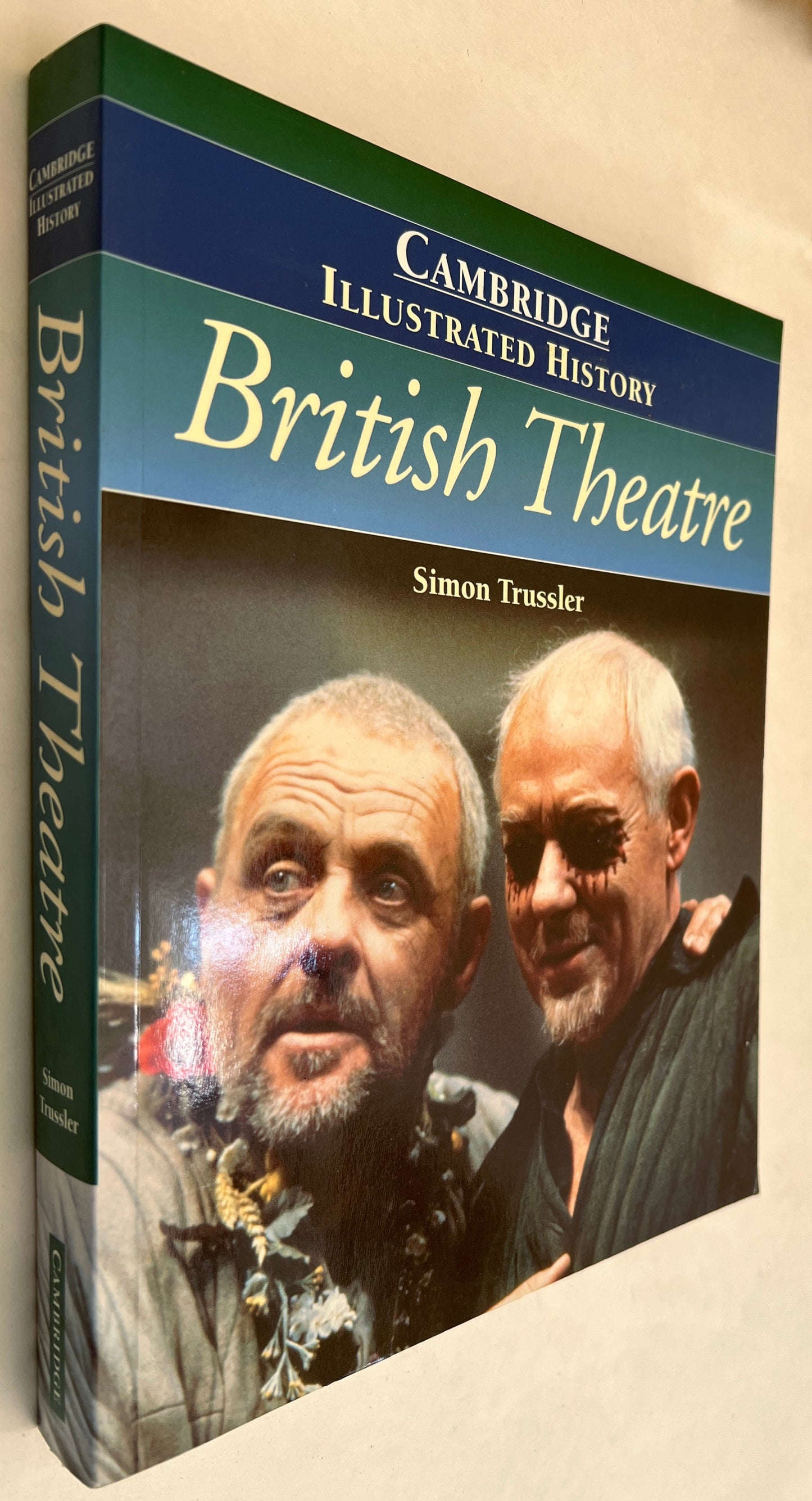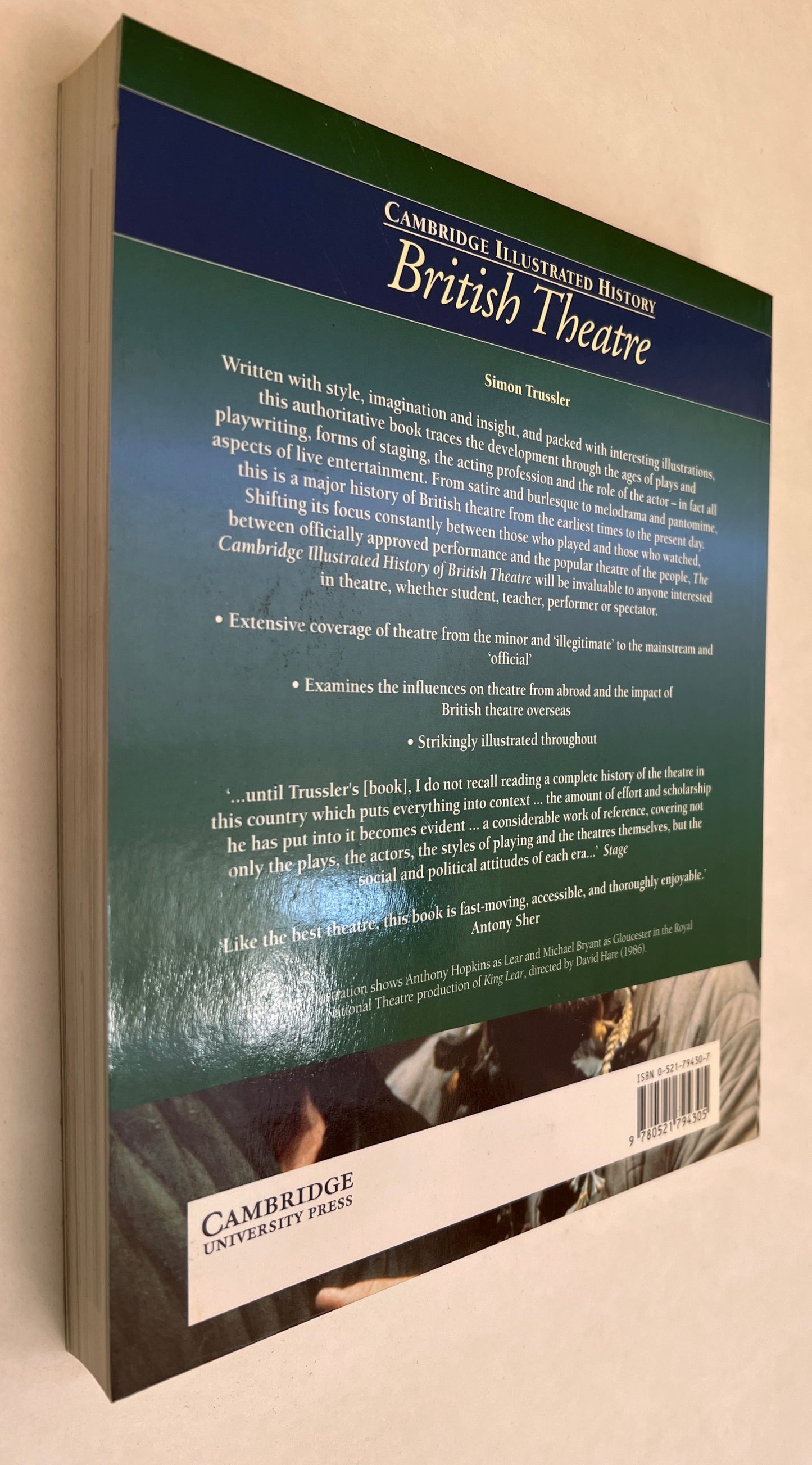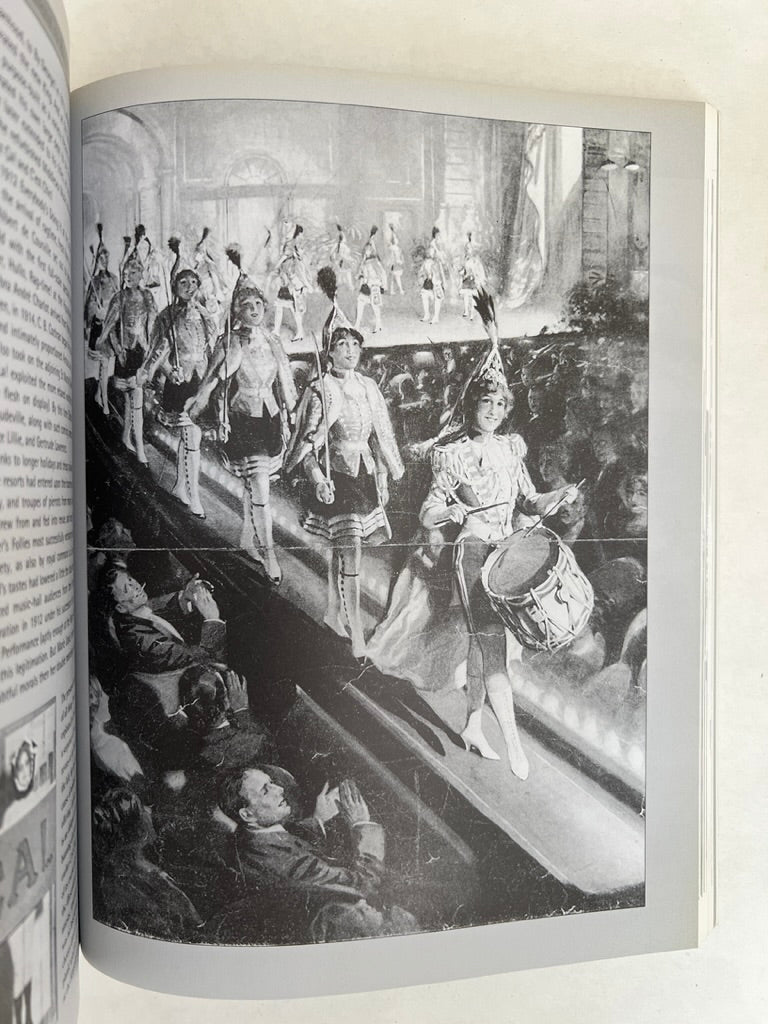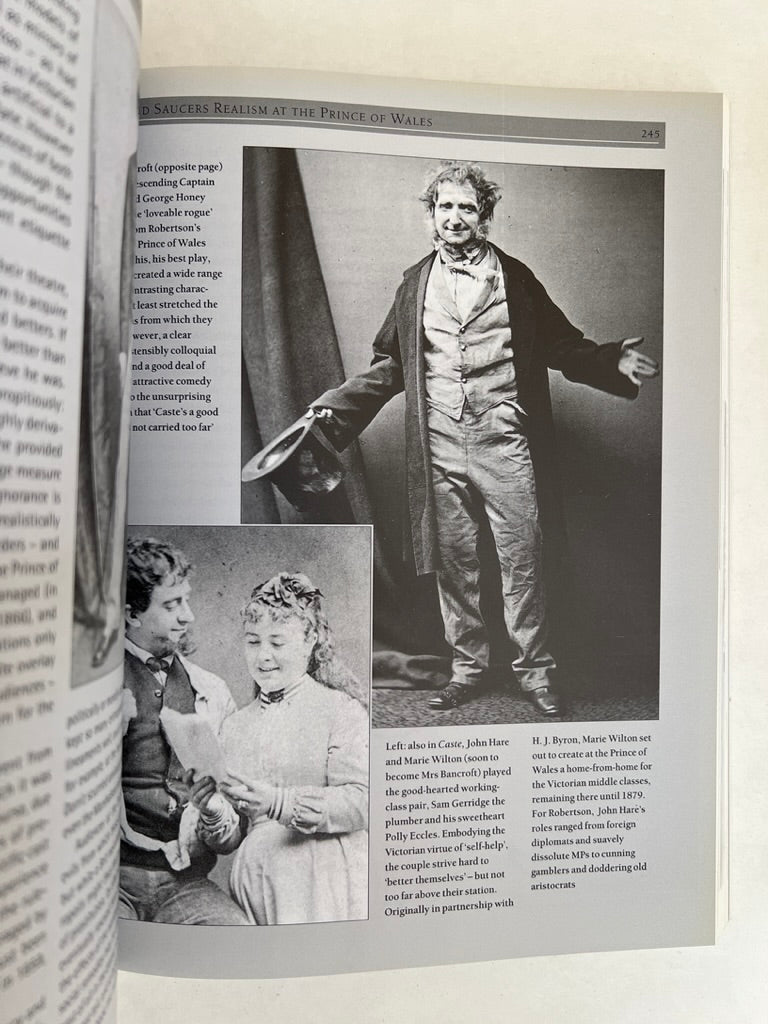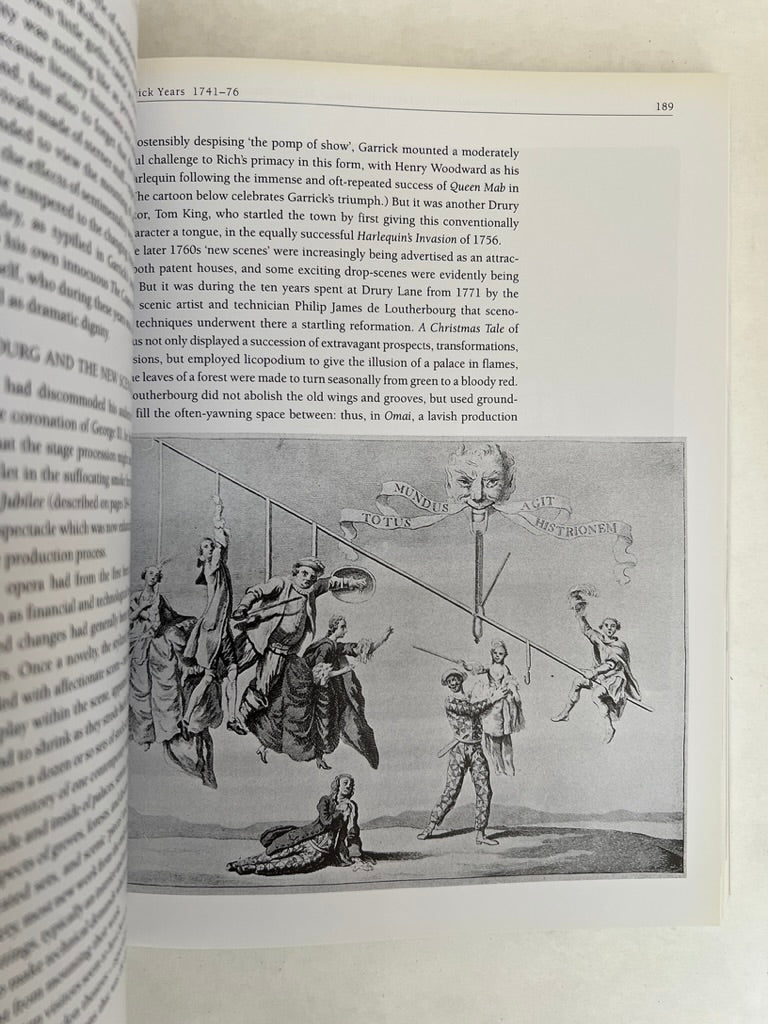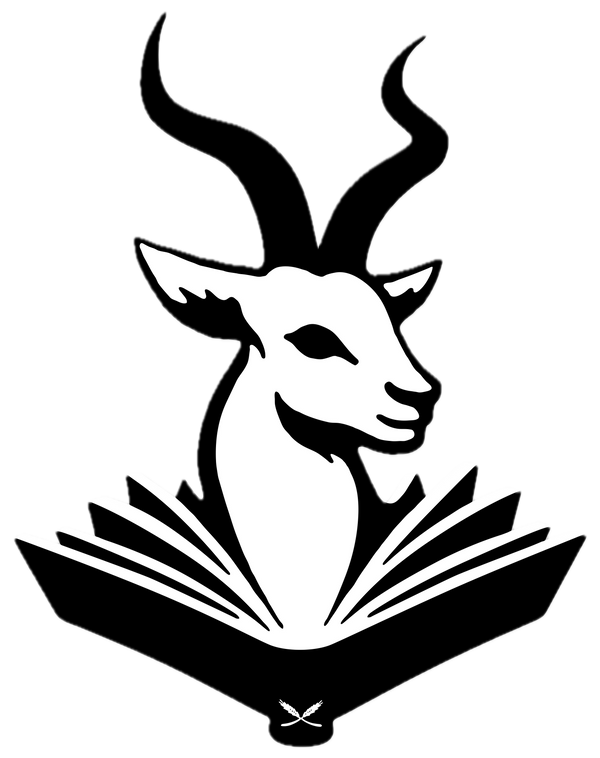Trussler, Simon.
The Cambridge Illustrated History of British Theatre
The Cambridge Illustrated History of British Theatre
No se pudo cargar la disponibilidad de retiro
Cambridge ; New York, NY, USA: Cambridge University Press, 2000 (1994). First paperback edition (stated). xii, 404 pages: illustrations (some color); 26 cm; bibliographical references (pages 396-399) and index. Fine; as new. Appears unread. Paperback. ISBN: 9780521794305
"Combining authoritative writing with superb illustration, The Cambridge Illustrated History of British Theatre is a fascinating exploration of the development of the live performing arts. Taking a broad view of theatre, the book covers everything from the minor and 'illegitimate' to the mainstream and 'official' - whether the mystery plays of the Middle Ages or the 'real time drama' of Coronation Street, the courtly theatre of Shakespeare's day or the 'fringe' of the 1990s." "Theatre is considered throughout as the popular expression of its creators' and audiences' values and concerns. The contributions of players, patrons, playwrights, and audiences are vividly recounted, together with the social and political forces which inevitably influenced them." "Ranging from theatre in the metropolis to theatre in the provinces, the book also examines the influences on theatre from abroad and the impact of British theatre on the cultural scene beyond its own frontiers."--Jacket. ¶ Contents: 1. Roman Britain and the early Middle Ages 44-950 -- Traces of the theatre of Roman Britain -- Mimes in Dark Ages -- "Scops" and their recitals of epics for the elite -- The case of Caedmon and the impact of Christianization -- Seasonal celebrations of the people -- 2. The high Middle Ages 950-1300 -- Hrotsvitha's plays and "Terence stages" -- Christian ceremony and the liturgical drama -- Class and performance in a trilingual nation -- The Anglo-Norman plays -- The theatricalization of aristocratic behavior: courtly love and the "drama" of the tournament -- Minstrelsy -- The relevance of "carnival" -- 3. The later Middle Ages 1300-1485 -- Famine, plague, politics, and faith -- Midsummer "tamed": the Feast of Corpus Christi -- "Official" and unofficial" pageantry: from "entries" and tableaux to mystery plays -- The cycles as gothic art, their locations, and forms of staging -- Cornish rounds -- Clerks' plays and saints' lives -- Interludes, secular and moral -- Folk drama for the elite: mummings and disguisings -- 4. The shaping of a professional theatre 1485-1572 -- Theatricality and the Tudor myth -- Reformation and "mysteries" end -- Educational and academic drama -- From royal servants to professionals: fools, boy choristers, adult players -- Interludes: moral, political, and farcical -- romance, balladry, and the popular audience -- Playing places -- Evidence and its interpretation -- Instruments of control: the licensing of plays, the patronage of players -- 5. The era of the outdoor playhouses 1572-1603 -- Decline of provincial playing -- London's "theatre districts" -- First permanent playhouses -- Techniques of staging -- Organization and development of the major companies -- Actors, repertoires,:parts" and "lines" -- The university wits and the triumph of blank verse -- Comedies, histories, tragedies and jigs -- Playwriting as a profession: Shakespeare, Heywood, Jonson -- Return of the children and the "war of the theatres" -- Theatre at court -- Death of a consummate actress -- Reconstructing the theatres -- 6. The Jacobean theatre 1603-1625 -- From Elizabethan to Jacobean -- New patrons, and the "move indoors" -- Changing audiences and changing tastes -- Acts and scenes -- The nature of "character": the malcontent and the revenger -- Conventions, cross-dressing, and clowning -- Tragedy, tragi-comedy, and the "triumvirate of wit" -- Masques -- "City comedy," the puritans, and the politics of theatre -- 7. The Caroline and Commonwealth theatre 1625-1660 -- Plague, patronage, and the players -- Audiences -- The Queen, the court, and the triumph of spectacle in the masque -- Playwrights, cavalier and professional -- Political plays and the play of politics -- The closure of 1642 and the plight of the actors -- The residual theatre of the interregnum: closet plays, drolls and opera by default -- Theories of reformed state -- 8. The Restoration theatre 1660-1682 -- Rival companies, their players, and their playhouses -- Wings and shutters -- Foreign influences and native growth -- Hobbes and the ideology of pleasure -- The King, the court, and varieties of "acting" -- Amateurs and professionals -- Society, sexuality, and new styles of comedy -- Heroic drama, neoclassicism, and what happened to Shakespeare -- The theatrical profession and the exclusionist crisis -- Shakespeare refashioned.; 9. The birth of a bourgeois theatre 1682-1707 -- United Company: plays, politics, audiences -- Betterton defects to Lincoln's Inn -- Attitudes to actresses, and the development of the benefit system -- "Rules" of acting -- Colley Cibber -- Collier controversy, the city, and the credit economy -- George Farquhar and "hard" versus "humane" comedy -- The female wits -- 10. The actors ascendant 1707-1728 -- Actors and the disappearing apron -- Drury Lane and the era of actor-management -- Beginnings of theatre criticism -- Wilks, Booth, and the "ranting school" -- Pathetic tragedy, reformed comedy -- The multiple bill and the popularity of farce -- John Rich at Lincoln's Inn Fields and the birth of English pantomime -- Patterns of performance -- Theatre in the suburbs, the fairs, and the provinces -- Shakespeare: for stage and for study -- 11. Opposition and oppression 1728-1741 -- The Whig ascendancy consolidated -- The rise of Walpole and of ballad opera -- New audiences, new theaters -- Fielding, Lillo, and the theatrical opposition -- Power struggles at Drury Lane -- The building of Covent Garden -- "The Great Mogul" at the Little theatre -- Dramatic satire -- The passing of the Licensing Act -- The end of experiment -- Actors and acting -- Garrick at Goodman's Fields -- The acting style of David Garrick -- 12. The Garrick years 1741-1776 -- Imperialism emergent, respectability triumphant -- Competition from the novel -- Garrick goes to Drury Lane -- The leading actors and their styles -- Foote at the Little and Colman at Covent Garden -- Comedy, tragedy and sentimentality -- the Shakespeare industry gathers pace -- Spectacle and pantomime -- De Loutherbourg and the scenographic revolution -- The fairgrounds dispossessed, the province legitimized -- Dawn of the industrial revolution and of the movement for reform -- 13. From manners to melodrama 1776-1814 -- The Sheridan phenomenon -- From mannered comedy to political spectacle -- Enlargement of the patent houses -- Minor theatres and the origins of melodrama -- Naval drama, topical and gothic spectacle -- Underclass as audience -- Tableaux vivants -- The "compilation bill" -- Philip Astley and Joe Grimaldi -- The "Kemble religion" -- The point of "points" -- Significance of the OP Riots -- Kean: the anarchy of the passions -- 14. The end of the monopoly 1814-1843 -- The theatre and political reform -- Neighborhood playhouses -- Competition in the West End -- The decline of the patent theaters -- Innovations in theater design -- Style in comedy -- Coming of the critics -- Kinds of melodrama -- Extravaganzas, burlesques, burlettas, and prehistory of the music hall -- The Theatres Act and the Riot Act -- 15. Towards a respectable theatre 1843-1871 -- Class, cash, and theater -- The growth of the music hall -- From stock to touring -- the railway age -- Effects of the long run -- The quest for respectability -- Boucicault and Tom Taylor -- Vintage years of farce -- West End and neighborhood theatre -- Phelps at Sadler's Wells -- The quest for "archaeological" accuracy -- Cups and saucers realism at the Prince of Wales.; 16. The speculative theatre 1871-1891 -- Popular culture, the Victorian Christmas, and the new pantomime -- Music hall as big business -- Political reform and economic decline -- A boom in theater building -- The coming of electricity -- Irving, the fashionable tragedian -- Management and influence of the Lyceum -- Prosperity in the West End -- New laws of copyright, and harbingers of a "new drama" -- Light opera, farce, and society drama: Gilbert, Pinero, Jones, and Wilde -- Critical controversy: Scott, Archer, and Bernard Shaw -- Influences from abroad and intimations of Ibsenism -- 17. Romance and realism 1891-1914 -- From Victorian to Edwardian -- The social and intellectual divide -- The actor-managers and the vogue for romance -- Actresses, the "woman question" and the suffragette drama -- The problem play and the nature of naturalism -- The play-producing societies and the Vedrenne-Barker partnership -- Playwrights and popularity -- The self-fashioning of Bernard Shaw -- Censorship, training and organization -- The repertory movement and the Irish Renaissance -- Approaches to Shakespeare: Poel, Barker, and Craig -- Musical comedy and revue -- Music hall and the arrival of cinema -- 18. The war and the long weekend 1914-1939 -- The First World War and after -- Expansion on Shaftesbury Avenue -- Old dramatists, new dramatists and directors -- A scenographic renaissance -- The "other theatre" -- Stratford and the Old Vic -- Actors and vehicles -- The cinema, the provinces, and the declining music hall -- The coming of broadcasting -- The autodidactic 'thirties -- Amateur theatre and the one-act play -- The Workers' Theatre Movement -- Intimations of war and the theatrical response -- 19. The utility theatre 1939-1956 -- Paradoxes of a people's war -- The theatre and the blitz -- ABCA, ENSA, and CEMA -- The Old Vic in exile -- The return of "true repertoire" -- The Arts Council, the provinces, and the "the Group" -- Escapism in the West End -- Acting style in an age of austerity -- The false dawn of poetic drama -- The Festival of Britain -- Radio comedy and drama, from the Archers to the Third Programme -- Theatre Workshop -- The little theatres in decline, Godot in waiting -- New ideas in Stratford -- Influences from the universities and from abroad -- 20. Anger and affluence 1956-1968 -- A political and theatrical watershed -- New drama at the Royal court -- Theatre Workshop: crippled by success -- The ensemble ideal and the creation of the Royal Shakespeare company -- A National Theatre at last -- Television drama -- The satire boom, the "second wave" and experimental stirrings -- Civic theatres come on stream -- A minister for the arts -- Expectations and intimations -- 21. Alternative theatres 1968-1979 -- Theatre and the "events" of 1968 -- Stirrings on the fringe -- The permissive society and the abolition of censorship -- The Arts Lab, new spaces, and the legacy of "cruelty" -- Collective creation and environmental theatre -- Into the 'seventies: agitational and political theatre -- Community groups, the arts centre movement, and theatre-in-education -- New writing moves into the mainstream -- Joint Stock and the royal Court -- Changes at the National and the RSC -- Feminist, gay, and ethnic theatre -- The Arts Council in a changing climate -- 22. Theatre and the marketplace 1979-1990 -- Politics and economics of Thatcherism -- Sponsorship and the theatre -- The Arts Council in the 'eighties and some clients -- Institutional and West End theatre -- The decade of the musical -- The international dimension -- The fringe: from counter-culture to chamber theatre -- Alternative comedy -- Female and male: directors, actors, dramatists -- Plays f or changing times -- Heritage as theatre, the taste for spectacle and the curious case of karaoke -- The theatre of the streets, and a cautionary tale -- Epilogue -- Chronology -- Glossary.¶
Théâtre -- Grande-Bretagne -- Histoire. Theater. Toneel. Théâtre -- Grande-Bretagne -- Histoire. History. Geographic: Great Britain.
Compartir
